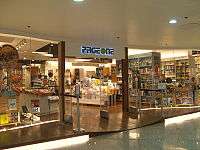Page One (bookstore)
 | |
| Industry | Retail |
|---|---|
| Genre | Various |
| Founded | 1983 |
| Founder | Mr. Mark Tan |
| Headquarters | Singapore |
Number of locations | China |
Area served | Worldwide |
| Products | Books, Gifts, and Stationeries |
| Website |
pageonegroup |
Page One (Chinese: 葉壹堂; pinyin: Yèyī Táng) is a bookstore chain and publisher founded in Singapore by Mark Tan (陳家強), with locations in Singapore, Hong Kong, Taiwan, Malaysia, and Thailand. Traditionally focused on English language books, it has recently expanded into the Chinese language market. However the shops have been closed in Singapore in 2011, Taiwan in 2016 and Hong Kong in November, 2016.
History
Page One began in 1983, when a small shop stocking handpicked art and design books opened in a shopping mall in Singapore. The small shop accumulated a loyal following over the years and evolved into a brand.[1]
Since then, Page One has marked its presence with bookstores in China, Hong Kong, Singapore, Thailand and Taiwan.[1] In Singapore, the Page One bookstore is established at VivoCity, the shopping mall touted to be the largest of its kind on the island.
While it began as a retail outfit, Page One has also expanded in the areas of book publishing and distribution over the years.[1] In publishing, Page One builds its strength from the acquisition of rights and creation of original in-house titles, with a focus on art and design content. Page One Publishing also brought its created titles to the West by selling territorial rights. These titles have been translated into eleven different languages. As a distributor, Page One has established a strong network in Asia and the rest of the world.
Controversies
The chain managed to obtain approval for opening outlets in mainland China in early 2010s, and started reducing the number of political books stocked. No books deemed to be on sensitive topics are sold inside the country, except Hong Kong.[2]
Shortly after the disappearance of five people linked to an independent Hong Kong book publishing house, the chain removed these books from their store at Hong Kong airport. The company will stop selling these titles in Hong Kong once existing stocks have been exhausted, leading to criticisms from academics that this forced disappearance from bookshop shelves as a result of the case was blatant self-censorship.[2]
Design
Mark Tan and his brother, architect Kay Ngee Tan (Chinese: 陳家毅), uniquely incorporated Southeast Asian art into their stores. For instance in Taipei, Vietnamese, Burmese and Thai etc., artworks were specially designed for the store, which customers could also purchase.
Southeast Asian clothworks decorate Page One stores and the decor is changed every season. This design initiative brought about the rise of "giant"-sized bookstores in Asia.
Store locations
- Singapore (Flagship Store)
- Vivo City – Ceased operations on 19 February 2012
- Hong Kong
- 2/F, Century Square, 1–13 D'Aguilar Street, Central[3][4] – Ceased operations
- Festival Walk, Kowloon Tong – Ceased operations on 17 November 2016
- Harbour City, Tsim Sha Tsui – Ceased operations on 17 November 2016
- Times Square, Causeway Bay (formerly known as One Twins, closed in Feb, 2015)
- Hong Kong International Airport (five stores in Terminal 1, one in Terminal 2 – formerly of British retailer W H Smith)
- China
- China World Mall, Beijing
- Mix City, Hangzhou
- International Finance Centre, Chengdu
- Taipei
- Taipei 101 (Closed in July, 2015)
- SOGO Fuxing (Closed)
- Bangkok
- CentralWorld
- CentralPlaza Bangna
- CentralPlaza Pinklao
- CentralPlaza Chaengwattana
- Central Chidlom
- Esplanade Ratchadaphisek
- Chiang Mai
- CentralPlaza Chiang Airport
- CentralFestival Chiang Mai (2013)
- Pattaya
- Phuket
- CentralFestival Phuket
- Jungceylon
References
- 1 2 3 "Page One Group". Page One. Page One Group. Retrieved 2016-04-20.
- 1 2 Ilaria Maria Sala (7 January 2016). "Hong Kong bookshops pull politically sensitive titles after publishers vanish". The Guardian.
- ↑ Hong Kong Directory
- ↑ Hilditch, Tom; Lau, Shirley (July 2002). "Boozers beat the buzzer". South China Morning Post. Hong Kong. Retrieved 30 December 2014.
External links
| Wikimedia Commons has media related to Page One (bookstore). |
- Page One Group Official site